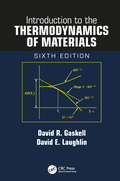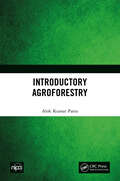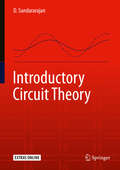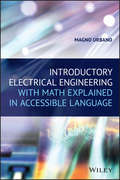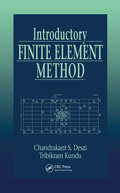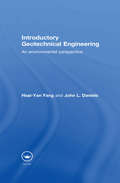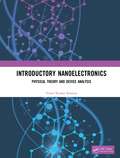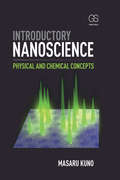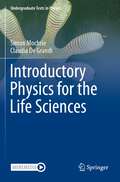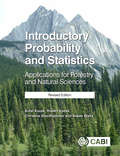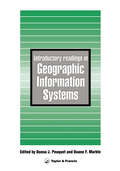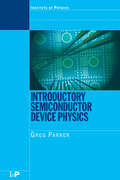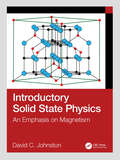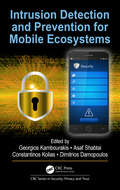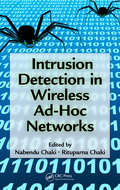- Table View
- List View
Introduction to the Thermodynamics of Materials
by David R. Gaskell David E. LaughlinMaintaining the substance that has made Introduction to the Thermodynamics of Materials a perennial bestseller for decades, the Seventh Edition is updated to reflect the broadening field of materials science and engineering. Chapters are updated and revised throughout to be more useful and logical for students. Features more than 60 new homework problems for the students, a listing of terms and concepts introduced, and a summary section Includes more on mathematical and graphical analysis of the various state functions utilized in classical thermodynamics Includes a more extensive discussion of the third law of thermodynamics Features a new appendix on exact differential equations and mathematical relationships, including all mathematical relations among differentials of homogeneous functions utilized in the text Written as the definitive introduction to the thermodynamic behavior of materials systems, this text presents the underlying thermodynamic principles of materials and their applications and continues to be the best undergraduate textbook in thermodynamics for materials science students. An updated solutions manual is also available for qualifying adopting professors.
Introduction to the Thermodynamics of Materials (6th Edition)
by David R. Gaskell David E. LaughlinMaintaining the substance that made Introduction to the Thermodynamic of Materials a perennial best seller for decades, this Sixth Edition is updated to reflect the broadening field of materials science and engineering. The new edition is reorganized into three major sections to align the book for practical coursework, with the first (Thermodynamic Principles) and second (Phase Equilibria) sections aimed at use in a one semester undergraduate course. The third section (Reactions and Transformations) can be used in other courses of the curriculum that deal with oxidation, energy, and phase transformations. The book is updated to include the role of work terms other than PV work (e.g., magnetic work) along with their attendant aspects of entropy, Maxwell equations, and the role of such applied fields on phase diagrams. There is also an increased emphasis on the thermodynamics of phase transformations and the Sixth Edition features an entirely new chapter 15 that links specific thermodynamic applications to the study of phase transformations. The book also features more than 50 new end of chapter problems and more than 50 new figures.
Introductory Agroforestry
by Alok Kumar PatraThe origin of agroforestry practices—growing trees and shrubs with food and fruit crops and grasses is traditional and very old—but the science of agroforestry is new. Years of experience and experiments have shown that agroforestry as a land-use system is capable of yielding both food and wood and at the same time helps in conserving and rehabilitating the ecosystems. It has the capability to increase the overall productivity of land, maintain the nutrient balance in the soil, and above all, protect the nature. In the recent years, agroforestry has been recommended as a core subject in the curriculum of B. Sc. (Forestry) and B. Sc. (Agriculture) courses of agricultural universities. This book has been divided into ten chapters covering very comprehensive information on all aspects of agroforestry including history, concepts, systems classification, tree-crop interactions, planning and management, diagnosis and design, policy and projects, and propagation and management practices of multipurpose trees. This book is co-published with NIPA. Taylor and Francis does not sell or distribute its print and electronic editions in India, Pakistan, Nepal, Bhutan, Bangladesh and Sri Lanka.
Introductory Biomedical Imaging: Principles and Practice from Microscopy to MRI (Imaging in Medical Diagnosis and Therapy)
by Bethe A. Scalettar James R. AbneyImaging is everywhere. We use our eyes to see and cameras to take pictures. Scientists use microscopes and telescopes to peer into cells and out to space. Doctors use ultrasound, X-rays, radioisotopes, and MRI to look inside our bodies. If you are curious about imaging, open this textbook to learn the fundamentals. Imaging is a powerful tool in fundamental and applied scientific research and also plays a crucial role in medical diagnostics, treatment, and research. This undergraduate textbook introduces cutting-edge imaging techniques and the physics underlying them. Elementary concepts from electromagnetism, optics, and modern physics are used to explain prominent forms of light microscopy, as well as endoscopy, ultrasound, projection radiography and computed tomography, radionuclide imaging, and magnetic resonance imaging. This textbook also covers digital image processing and analysis. Theoretical principles are reinforced with illustrative homework problems, applications, activities, and experiments, and by emphasizing recurring themes, including the effects of resolution, contrast, and noise on image quality. Readers will learn imaging fundamentals, diagnostic capabilities, and strengths and weaknesses of techniques. This textbook had its genesis, and has been vetted, in a "Biomedical Imaging" course at Lewis & Clark College in Portland, OR, and is designed to facilitate the teaching of similar courses at other institutions. It is unique in its coverage of both optical microscopy and medical imaging at an intermediate level, and exceptional in its coverage of material at several levels of sophistication.
Introductory Circuit Theory
by D. SundararajanThis textbook for a one-semester course in Electrical Circuit Theory is written to be concise, understandable, and applicable. Matlab is used throughout, for coding the programs and simulation of the circuits. Every new concept is illustrated with numerous examples and figures, in order to facilitate learning. The simple and clear style of presentation, along with comprehensive coverage, enables students to gain a solid foundation in the subject, along with the ability to apply techniques to real circuit analysis. Written to be accessible to students of varying backgrounds, this textbook presents the analysis of realistic, working circuitsPresents concepts in a clear, concise and comprehensive manner, such as the difficult problem of setting up the equilibrium equations of circuits using a systematic approach in a few distinct stepsIncludes worked examples of functioning circuits, throughout every chapter, with an emphasis on real applicationsIncludes numerous exercises at the end of each chapter Provides program scripts and circuit simulations, using the popular and widely used Matlab software, as supplementary material online
Introductory Electrical Engineering With Math Explained in Accessible Language: Math Foundation Explained
by Magno UrbanoOffers an understanding of the theoretical principles in electronic engineering, in clear and understandable terms Introductory Electrical Engineering With Math Explained in Accessible Language offers a text that explores the basic concepts and principles of electrical engineering. The author—a noted expert on the topic—explains the underlying mathematics involved in electrical engineering through the use of examples that help with an understanding of the theory. The text contains clear explanations of the mathematical theory that is needed to understand every topic presented, which will aid students in engineering courses who may lack the necessary basic math knowledge. Designed to breakdown complex math concepts into understandable terms, the book incorporates several math tricks and knowledge such as matrices determinant and multiplication. The author also explains how certain mathematical formulas are derived. In addition, the text includes tables of integrals and other tables to help, for example, find resistors’ and capacitors’ values. The author provides the accessible language, examples, and images that make the topic accessible and understandable. This important book: • Contains discussion of concepts that go from the basic to the complex, always using simplified language • Provides examples, diagrams, and illustrations that work to enhance explanations • Explains the mathematical knowledge that is crucial to understanding electrical concepts • Contains both solved exercises in-line with the explanations Written for students, electronic hobbyists and technicians, Introductory Electrical Engineering With Math Explained in Accessible Language is a much-needed text that is filled with the basics concepts of electrical engineering with the approachable math that aids in an understanding of the topic.
Introductory Elements of Analysis and Design in Chemical Engineering
by Bruce C. Gates Robert L. PowellIntroductory Elements of Analysis and Design in Chemical Engineering introduces readers to how chemical engineers think. It explains the application of analytical methods to phenomena important in chemical engineering and teaches analytical skills in the context of engineering design. A principle goal is to help readers reinforce their understanding of mathematics (especially calculus) and science as they are introduced to engineering thinking. Key Features: • Emphasizes basic principles, methods, and problem solving at an elementary level. • Presents concepts in calculus, chemistry, and physics and methods of analysis on the basis of experiment and observation. • Connects experimental results to mathematical representations. • Provides numerous illustrative examples and builds on them to introduce processing and process flow diagrams and to place chemical engineering in an historical context. • Includes problems at the end of each chapter. Aimed at readers beginning their studies in chemical engineering, this textbook offers an approachable introduction to the principles of analysis and design in chemical engineering to help readers learn to think quantitatively and with a foundation of chemical engineering concepts.
Introductory Finite Element Method (Mechanical and Aerospace Engineering Series)
by Tribikram Kundu Chandrakant S. DesaiAlthough there are many books on the finite element method (FEM) on the market, very few present its basic formulation in a simple, unified manner. Furthermore, many of the available texts address either only structure-related problems or only fluid or heat-flow problems, and those that explore both do so at an advanced level.Introductory Finite Element Method examines both structural analysis and flow (heat and fluid) applications in a presentation specifically designed for upper-level undergraduate and beginning graduate students, both within and outside of the engineering disciplines. It includes a chapter on variational calculus, clearly presented to show how the functionals for structural analysis and flow problems are formulated. The authors provide both one- and two-dimensional finite element codes and a wide range of examples and exercises. The exercises include some simpler ones to solve by hand calculation-this allows readers to understand the theory and assimilate the details of the steps in formulating computer implementations of the method.Anyone interested in learning to solve boundary value problems numerically deserves a straightforward and practical introduction to the powerful FEM. Its clear, simplified presentation and attention to both flow and structural problems make Introductory Finite Element Method the ideal gateway to using the FEM in a variety of applications.
Introductory Geotechnical Engineering: An Environmental Perspective
by Hsai-Yang Fang John L. DanielsIntegrating and blending traditional theory with particle-energy-field theory, this book provides a framework for the analysis of soil behaviour under varied environmental conditions. This book explains the why and how of geotechnical engineering in an environmental context. Using both SI and Imperial units, the authors cover: rock mechanics soil mechanics and hydrogeology soil properties and classifications and issues relating to contaminated land. Students of civil, geotechnical and environmental engineering and practitioners unfamiliar with the particle-energy-field concept, will find that this book's novel approach helps to clarify the complex theory behind geotechnics.
Introductory Nanoelectronics: Physical Theory and Device Analysis
by Vinod Kumar KhannaThis introductory text develops the reader’s fundamental understanding of core principles and experimental aspects underlying the operation of nanoelectronic devices. The author makes a thorough and systematic presentation of electron transport in quantum-confined systems such as quantum dots, quantum wires, and quantum wells together with Landauer-Büttiker formalism and non-equilibrium Green’s function approach. The coverage encompasses nanofabrication techniques and characterization tools followed by a comprehensive exposition of nanoelectronic devices including resonant tunneling diodes, nanoscale MOSFETs, carbon nanotube FETs, high-electron-mobility transistors, single-electron transistors, and heterostructure optoelectronic devices. The writing throughout is simple and straightforward, with clearly drawn illustrations and extensive self-study exercises for each chapter. Introduces the basic concepts underlying the operation of nanoelectronic devices. Offers a broad overview of the field, including state-of-the-art developments. Covers the relevant quantum and solid-state physics and nanoelectronic device principles. Written in lucid language with accessible mathematical treatment. Includes extensive end-of-chapter exercises and many insightful diagrams.
Introductory Nanoscience: Physical and Chemical Concepts
by Masaru KunoDesigned for students at the senior undergraduate and first-year graduate level, Introductory Nanoscience takes a quantitative approach to describing the physical and chemical principles behind what makes nanostructures so fascinating. This textbook provides a foundation for understanding how properties of materials change when scaled to nano-size, explaining how we may predict behavior and functionality.
Introductory Physics for the Life Sciences (Undergraduate Texts in Physics)
by Simon Mochrie Claudia De GrandiThis classroom-tested textbook is an innovative, comprehensive, and forward-looking introductory undergraduate physics course. While it clearly explains physical principles and equips the student with a full range of quantitative tools and methods, the material is firmly grounded in biological relevance and is brought to life with plenty of biological examples throughout.It is designed to be a self-contained text for a two-semester sequence of introductory physics for biology and premedical students, covering kinematics and Newton’s laws, energy, probability, diffusion, rates of change, statistical mechanics, fluids, vibrations, waves, electromagnetism, and optics. Each chapter begins with learning goals, and concludes with a summary of core competencies, allowing for seamless incorporation into the classroom. In addition, each chapter is replete with a wide selection of creative and often surprising examples, activities, computational tasks, and exercises, many of which are inspired by current research topics, making cutting-edge biological physics accessible to the student.
Introductory Probability and Statistics: Applications for Forestry and Natural Sciences (Revised Edition)
by Robert Kozak Antal Kozak Christina Staudhammer Susan WattsAll students, practitioners and researchers in forestry and related disciplines need a good grounding in statistics and probability. This need is increasing as techniques for gathering and analysing large amounts of data are becoming commonplace. This revised edition of this unique textbook is specifically designed for statistics and probability courses taught to students of forestry and related disciplines. It introduces probability, statistical techniques, data analysis, hypothesis testing, experimental design, sampling methods, nonparametric tests and statistical quality control, using examples drawn from a forestry, wood science and conservation context. The book now includes several new practical exercises for students to practice data analysis and experimental design themselves. It has been updated throughout, and its scope has been broadened to reflect the evolving and dynamic nature of forestry, bringing in examples from conservation science, recreation and urban forestry. - Specifically written and designed to teach statistics and probability to students of forestry and related disciplines in the natural sciences - This revised edition has been broadened to reflect the dynamism of modern forestry -Chapters in this revised edition include new practical exercises allowing students to practice data analysis and experimental design
Introductory Quantum Mechanics with MATLAB: For Atoms, Molecules, Clusters, and Nanocrystals
by James R. ChelikowskyPresents a unique approach to grasping the concepts of quantum theory with a focus on atoms, clusters, and crystals Quantum theory of atoms and molecules is vitally important in molecular physics, materials science, nanoscience, solid state physics and many related fields. Introductory Quantum Mechanics with MATLAB is designed to be an accessible guide to quantum theory and its applications. The textbook uses the popular MATLAB programming language for the analytical and numerical solution of quantum mechanical problems, with a particular focus on clusters and assemblies of atoms. The textbook is written by a noted researcher and expert on the topic who introduces density functional theory, variational calculus and other practice-proven methods for the solution of quantum-mechanical problems. This important guide: -Presents the material in a didactical manner to help students grasp the concepts and applications of quantum theory -Covers a wealth of cutting-edge topics such as clusters, nanocrystals, transitions and organic molecules -Offers MATLAB codes to solve real-life quantum mechanical problems Written for master's and PhD students in physics, chemistry, material science, and engineering sciences, Introductory Quantum Mechanics with MATLAB contains an accessible approach to understanding the concepts of quantum theory applied to atoms, clusters, and crystals.
Introductory Readings In Geographic Information Systems
by Donna J. Peuquet Duane F. MarbleEven though Geographic Information Systems GIS have been available for over 20 years, they have only recently become accessible to geographers and others as a useful tool in spacial analysis. This book assembles a balanced sample of written works covering important aspects of the basic principles of GIS and selected examples of applications.
Introductory Semiconductor Device Physics
by Greg ParkerIntroduction to Semiconductor Device Physics is a popular and established text that offers a thorough introduction to the underlying physics of semiconductor devices. It begins with a review of basic solid state physics, then goes on to describe the properties of semiconductors including energy bands, the concept of effective mass, carrier concentr
Introductory Solid State Physics with MATLAB Applications
by Javier E. Hasbun Trinanjan DattaSolid state physics, the study and prediction of the fundamental physical properties of materials, forms the backbone of modern materials science and has many technological applications. The unique feature of this text is the MATLAB®-based computational approach with several numerical techniques and simulation methods included. This is highly effective in addressing the need for visualization and a direct hands-on approach in learning the theoretical concepts of solid state physics. The code is freely available to all textbook users. Additional Features: Uses the pedagogical tools of computational physics that have become important in enhancing physics teaching of advanced subjects such as solid state physics Adds visualization and simulation to the subject in a way that enables students to participate actively in a hand-on approach Covers the basic concepts of solid state physics and provides students with a deeper understanding of the subject matter Provides unique example exercises throughout the text Obtains mathematical analytical solutions Carries out illustrations of important formulae results using programming scripts that students can run on their own and reproduce graphs and/or simulations Helps students visualize solid state processes and apply certain numerical techniques using MATLAB®, making the process of learning solid state physics much more effective Reinforces the examples discussed within the chapters through the use of end-of-chapter exercises Includes simple analytical and numerical examples to more challenging ones, as well as computational problems with the opportunity to run codes, create new ones, or modify existing ones to solve problems or reproduce certain results
Introductory Solid State Physics: An Emphasis on Magnetism
by David C. JohnstonIntroductory Solid State Physics: An Emphasis on Magnetism acts as a supplement to students tackling solid state physics at both the undergraduate and graduate level. The BCS theory of superconductivity is not included in undergraduate-level books, because the theory is derived at the graduate level. However, this book uses the equations derived by BCS to calculate the thermodynamic properties of superconductors such as the temperature dependence of the heat capacity using techniques accessible to undergraduates. Also covering topics such as wave diffraction, the essentials of thermodynamics, statistical mechanics and local-moment magnetism, it is useful for those studying solid state physics at any level.Key Features: Includes the BCS theory of superconductivity Provides material that is accessible to students at all levels Approaches the subject with a particular emphasis on magnetism
Introduzione alla Meccanica dei Fluidi per Applicazioni Cardiovascolari
by Gianni Pedrizzetti Federico DomenichiniQuesto libro parte da una descrizione degli elementi fondamentali della meccanica dei fluidi nei grandi vasi sanguigni. A questo fine, viene introdotto un rigoroso background fisico accompagnato da esempi applicati alla circolazione, presentando risultati classici e sviluppi recenti relativi allo studio della dinamica sanguigna nella fisiologia cardiovascolare. Esplora poi argomenti più avanzati per una comprensione dei fenomeni, effettivamente riscontrati in cardiologia clinica, fondata sull’utilizzo delle leggi di conservazione della meccanica. Il testo si presenta come una risorsa di apprendimento ideale per fisici e ingegneri che si occupano di dinamica dei fluidi cardiovascolare, operatori nel settore delle tecnologie biomediche, studenti in biofluidodinamica. Il libro fornisce un filo conduttore tra i campi distanti della meccanica dei fluidi e della cardiologia clinica. Ben radicato nella teoria della dinamica dei fluidi, guida il lettore attraverso scenari progressivamente più realistici fino alla complessità delle applicazioni mediche di routine. Basato su oltre 25 anni di collaborazioni dell'autore con i cardiologi, aiuta gli ingegneri a imparare a comunicare con i clinici, mantenendo al contempo il rigore delle discipline scientifiche. Scritto in uno stile conciso, è un libro di testo accessibile a un ampio pubblico di lettori, tra cui studenti, fisici e ingegneri, offrendo un punto di ingresso a questo campo multidisciplinare. Include concetti chiave esemplificati da illustrazioni che utilizzano tecniche di analisi di immagini all'avanguardia e da riferimenti a metodi di modellazione e misurazione, e contiene intuizioni originali uniche.
Intrusion Detection and Prevention for Mobile Ecosystems (Series in Security, Privacy and Trust)
by Georgios Kambourakis, Asaf Shabtai, Constantinos Kolias and Dimitrios DamopoulosThis book presents state-of-the-art contributions from both scientists and practitioners working in intrusion detection and prevention for mobile networks, services, and devices. It covers fundamental theory, techniques, applications, as well as practical experiences concerning intrusion detection and prevention for the mobile ecosystem. It also includes surveys, simulations, practical results and case studies.
Intrusion Detection for IP-Based Multimedia Communications over Wireless Networks
by Jin Tang Yu ChengIP-based multimedia communications have become increasingly popular in recent years. With the increasing coverage of the IEEE 802:11(tm) based wireless networks, IP-based multimedia communications over wireless networks are also drawing extensive attention in both academia and industry. Due to the openness and distributed nature of the protocols involved, such as the session initiation protocol (SIP) and the IEEE 802:11(tm) standard, it becomes easy for malicious users in the network to achieve their own gain or disrupt the service by deviating from the normal protocol behaviors This SpringerBrief presents real-time intrusion detection techniques that can quickly track the malicious behaviors which manipulate the vulnerabilities from either the 802. 11(tm) or the SIP protocols. More specifically, this book presents interdisciplinary techniques to achieve an effective real-time intrusion detection system, which interweaves medium access control (MAC) protocol analysis, cumulative sum (CUSUM) based detector design, a novel Markovian model for CUSUM detectors, sketch-based traffic modeling, and wavelet based signal processing techniques.
Intrusion Detection in Wireless Ad-Hoc Networks
by Nabendu Chaki Rituparna ChakiPresenting cutting-edge research, Intrusion Detection in Wireless Ad-Hoc Networks explores the security aspects of the basic categories of wireless ad-hoc networks and related application areas. Focusing on intrusion detection systems (IDSs), it explains how to establish security solutions for the range of wireless networks, including mobile ad-hoc
Intuitionistic and Type-2 Fuzzy Logic Enhancements in Neural and Optimization Algorithms: Theory and Applications (Studies in Computational Intelligence #862)
by Oscar Castillo Patricia Melin Janusz KacprzykThis book describes the latest advances in fuzzy logic, neural networks, and optimization algorithms, as well as their hybrid intelligent combinations, and their applications in the areas such as intelligent control, robotics, pattern recognition, medical diagnosis, time series prediction, and optimization. The topic is highly relevant as most current intelligent systems and devices use some form of intelligent feature to enhance their performance. The book also presents new and advanced models and algorithms of type-2 fuzzy logic and intuitionistic fuzzy systems, which are of great interest to researchers in these areas. Further, it proposes novel, nature-inspired optimization algorithms and innovative neural models. Featuring contributions on theoretical aspects as well as applications, the book appeals to a wide audience.
Intuitions in Literature, Technology, and Politics: Parabilities (American Literature Readings in the 21st Century)
by Alan Ramón ClintonUsing the idea of 'parability,'or the ability for writers to tell improper stories, as a foundation, Alan Ramón Clinton synthesizes a new model for a creative, more daring literary criticism. Sharp and surprising, this wide-ranging project engages with the work of Pynchon, Eco, Forché, Merrill, Weiner, Plath, Ashbery, and Eigner.
Intuitive Interaction: Research and Application
by Alethea BlacklerThis book explores recent research in intuitive interaction worldwide by a range of leading academics and practitioners in the field. It builds on past work as it ventures into new areas, such as how users perceive intuitiveness of an interface, how people experience intuitive interaction subjectively, and how we can use such understanding to design more engaging experiences. The book addresses how intuitive interaction is understood in different academic disciplines and how it has been researched in various parts of the world over the last 18 years. It covers how intuitive interaction can be applied in different contexts, like large scale urban installations, the developing world, in older populations, and in various industry applications. <P><P>Features: <li>Presents varied approaches to intuitive interaction research and application <li>Illustrates how to understand and apply intuitive interaction to interfaces <li>Provides a mix of academic and industry perspectives <li>Explores a variety of contexts for application of intuitive interaction <li>Encompasses design, IT, business, and psychological approaches

